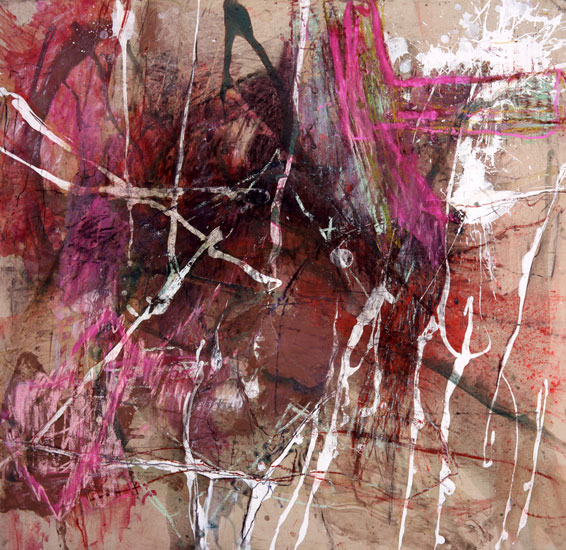
Cora Cohen
at Jason McCoy

Things belong to her and she belongs to other things, 2004, 46 x 48", acrylic, charcoal, copper, oil, oil pastel, pastel, pigment on muslin
Of the formerly avant-garde practice of gestural abstraction, Cora Cohen is a prominent defender of the faith, and these eight painting from 2004 might convince any doubters of its continued viability. The artist’s tenacity and fearlessness are palpable. She avails herself of acrylics, charcoal, copper, oil pastel, powdered pigment, flashe and graphite in application too unmannered to be called autographic. Largely devoid of the suggestion of landscape space that so often encumbers paintings of this sort, her works instead bring to mind atmospheric disturbances or occurrences undersea, where the effects of gravity are altered. Despite the judicious use of a few strong hues, in the end the work is more about surface and touch than color.
The storm of mark-making in Things Belong to Her and She Belongs to Other Things (46 by 48 inches) is anchored by an open linear structure of poured white acrylic ribs or struts, which supports the relentless rubbing and smearing although partly submerged in it. The spatial key is along the top edge, where a hot pink smear pops forward just to the right of the dark, backward hurtling vortex. There is breathing room around the edges of the painting, where the neutral gray of the muslin Cohen favors is allowed to show and produces a vignette effect.
A central massing of dark also organizes Another Order of Being (38 by 48 inches), wherein, a restless cloud of warm browns and cool blacks, shot through with alizarin glaze like cherry syrup, act as a foil for exploratory slashes of pastel in electric blue, red and pale green. The goopy surface is pocked with craters where bubbles burst. Cohen is good at not tidying up. Caked oil pastel pulled across the crinkled furrows of slick acrylic glazes in The Periphery ( 29 by 46 inches) is wincingly ugly, but in keeping it the artist insists that the imperative of improvisational freedom is greater than the niceties of technique, or taste.
In the larger paintings, each nearly 6 feet square, Cohen paints without the safety net of the vignette structure and thus de-emphasizes the importance of the paintings’ edges. Heart of Darkness sports Turneresque torrents of impasto suffused with the chromatic valence of red and green, but the values remain quite close. Complicity and Resistance pushes further still into formlessness with a clotted field of stains in a whitish mist. Pentimento is not a feature of the painting, it is its method. The extremely complex surface is a matrix of revered pictorial decisions. Part of an awkward purple scrape is allowed to remain; jaundiced patches are left from an earlier notion of yellow. The urgency that propels the other paintings is here replaced by deliberation upon the Action painter’s problem of knowing when to stop. -Stephen Maine